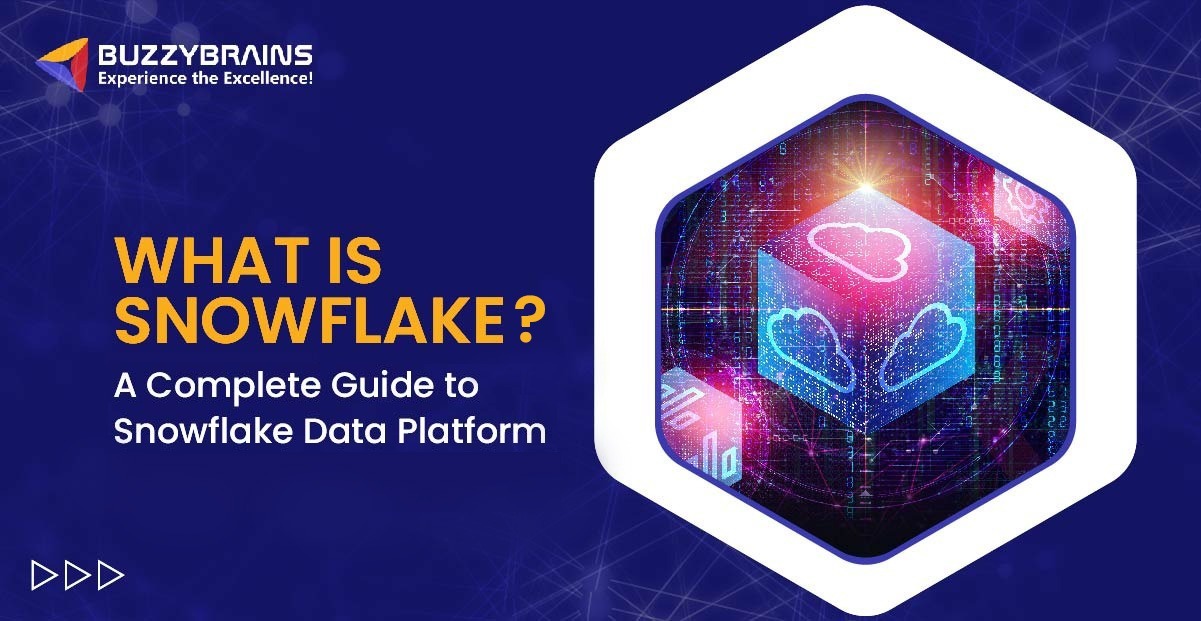What is Snowflake? A Complete Guide to Snowflake Data Platform

In today’s data-driven world, businesses are continuously seeking efficient, scalable solutions to manage their ever-growing data. Snowflake has emerged as a leading player in the realm of data warehousing, offering a cloud-based solution that simplifies data storage, processing, and analysis. Whether you’re a seasoned data professional or just starting, understanding the Snowflake Data Platform is crucial for leveraging its full potential. In this guide, we’ll explore what Snowflake is, its key features, how it works, its advantages, common challenges, use cases, and more.
What is a Snowflake?
Snowflake is a cloud-based data warehousing platform that provides a unique blend of flexibility, scalability, and ease of use. Unlike traditional data warehouses, Snowflake is designed from the ground up to work in the cloud. It decouples storage and compute resources, allowing for independent scaling of both, which is a significant departure from legacy on-premises solutions.
Snowflake’s architecture is built to handle both structured and semi-structured data, making it a versatile tool for modern data needs. It supports a wide range of data workloads, including data warehousing, data lakes, data engineering, data science, and data application development. Snowflake’s ability to manage large volumes of data with high performance and minimal administrative overhead has made it a popular choice for organizations of all sizes.
Related Blog: What is Microsoft SSIS: Key Features, Benefits and More
Key Features of Snowflake
Snowflake’s success can be attributed to several key features that set it apart from traditional data warehousing solutions. These features include:
- Multi-Cloud Availability: Snowflake runs on multiple cloud platforms, including AWS, Azure, and Google Cloud, offering flexibility and avoiding vendor lock-in.
- Scalability: It can automatically scale compute resources up or down based on workload demands, ensuring optimal performance at all times.
- Seamless Data Sharing: Snowflake enables secure and governed data sharing across organizations without needing to copy or move data.
- Support for Structured and Semi-Structured Data: Snowflake natively supports JSON, Avro, Parquet, and other formats, allowing seamless handling of semi-structured data.
- Zero-Copy Cloning: This feature allows users to create instant, space-efficient copies of databases, which is ideal for development, testing, and analytics.
- Time Travel: Snowflake’s Time Travel feature allows users to access historical data, which is useful for auditing, recovery, and compliance purposes.
- Automatic Optimization: The platform automatically optimizes storage and queries, reducing the need for manual tuning and maintenance.
- Security and Compliance: Snowflake includes comprehensive security features such as end-to-end encryption, role-based access control, and compliance with industry standards like GDPR and HIPAA.
How Does Snowflake Architecture Work?
Understanding how Snowflake works involves exploring its architecture, which is fundamentally different from traditional data warehouses. Snowflake’s architecture can be broken down into three layers:
1. Storage Layer:
This layer handles the storage of data in a highly optimized and compressed format. Snowflake automatically manages the organization, file size, structure, compression, metadata, and other aspects of stored data. Data stored in Snowflake is organized into multiple micro partitions, which are immutable and automatically optimized for performance.
2. Compute Layer (Virtual Warehouses):
The compute layer consists of virtual warehouses, which are independent compute clusters that execute queries. Each virtual warehouse can be scaled independently of the others, and multiple virtual warehouses can operate on the same data simultaneously. This separation of compute and storage allows for flexibility in resource allocation and ensures that workloads do not interfere with each other.
3. Cloud Services Layer:
The cloud services layer orchestrates and manages Snowflake operations. It includes services such as query optimization, access control, and metadata management. This layer is what enables Snowflake’s elasticity, allowing it to scale resources automatically based on demand.
Advantages of Using Snowflake
Snowflake offers numerous advantages that make it a compelling choice for organizations looking to modernize their data infrastructure. Some of the key benefits include:
- Cost Efficiency: Snowflake’s pay-as-you-go pricing model allows organizations to scale resources based on actual usage, which can lead to significant cost savings compared to traditional data warehouses.
- Performance: Snowflake’s architecture is optimized for speed, allowing for fast query execution, even with large data sets and complex queries.
- Scalability: The platform can scale both storage and compute independently, ensuring that performance remains consistent as data volumes grow.
- Ease of Use: Snowflake offers a simple, intuitive interface and supports standard SQL, making it accessible to a wide range of users without the need for specialized training.
- Data Sharing: Snowflake’s unique approach to data sharing allows for secure, real-time data collaboration between different organizations and departments.
- Flexibility: Snowflake supports both structured and semi-structured data, providing the flexibility to handle a wide range of data types and formats.
- Security: With built-in encryption, role-based access control, and compliance with industry standards, Snowflake ensures that data is secure and meets regulatory requirements.
Common Challenges with Snowflake and How to Overcome Them
While Snowflake offers many benefits, like any technology, it comes with its own set of challenges. Here are some common challenges users may face and how to overcome them:
1. Data Migration:
Migrating data to Snowflake can be complex, especially when dealing with large volumes of data from various sources.
Solution: Plan the migration carefully, use Snowflake’s migration tools, and consider a phased approach to minimize downtime and disruptions.
2. Cost Management:
While Snowflake’s pay-as-you-go model is cost-effective, unexpected costs can arise if resources are not managed carefully.
Solution: Implement resource monitoring and cost control measures, such as setting up alerts and using Snowflake’s resource management features to optimize usage.
3. Learning Curve:
For teams new to cloud data platforms, there may be a learning curve associated with using Snowflake.
Solution: Provide training and resources to help users get up to speed. Snowflake offers extensive documentation and community support that can be leveraged.
4. Data Governance:
Ensuring data quality and consistency across a large, distributed environment can be challenging.
Solution: Implement strong data governance practices, including data lineage tracking, data quality checks, and standardized processes for data management.
Snowflake Use Cases
Snowflake is a versatile platform that can be used for a wide range of data-related tasks. Here are some common use cases where Snowflake shines:
1. Data Warehousing:
Snowflake’s core use case is as a scalable, cloud-based data warehouse. It provides a centralized repository for all business data, enabling efficient storage, processing, and analysis.
2. Data Lakes:
Snowflake can also function as a data lake, storing large volumes of raw, unstructured, and semi-structured data. Its ability to handle different data formats natively makes it an ideal choice for this purpose.
3. Real-Time Analytics:
Snowflake supports real-time data processing and analytics, allowing businesses to make data-driven decisions quickly. Its ability to scale compute resources on demand ensures that even large, complex queries can be processed efficiently.
4. Data Sharing:
Snowflake’s data sharing capabilities enable secure, controlled sharing of data across different teams, departments, or even external partners. This is particularly useful for collaborative projects or situations where data needs to be accessed by multiple stakeholders.
5. Data Science and Machine Learning:
Snowflake integrates with various data science and machine learning tools, providing a platform for advanced analytics and predictive modeling. Its scalability and performance make it well-suited for handling the large datasets typically used in these applications.
6. Data Engineering:
Snowflake can be used as a platform for data engineering tasks, such as ETL (Extract, Transform, Load) processes. Its support for automated ETL processes and integration with various data tools simplifies data pipelines and ensures that data is always up-to-date and ready for analysis.
FAQs about Snowflake Data Platform
Q1. How does Snowflake’s architecture work?
Snowflake’s architecture is built on three layers: the storage layer, compute layer (virtual warehouses), and cloud services layer. This design allows for the separation of storage and compute, enabling independent scaling of each component. The cloud services layer manages metadata, query optimization, and other functions, ensuring efficient operation and performance.
Q2. What is the pricing model for Snowflake?
Snowflake uses a pay-as-you-go pricing model, where customers are charged based on the amount of data stored and the compute resources used. This model allows for cost efficiency, as organizations only pay for the resources they actually use. There are also options for pre-purchased capacity, which can provide cost savings for consistent workloads.
Q3. Can Snowflake integrate with other data tools and platforms?
Yes, Snowflake is designed to integrate with a wide range of data tools and platforms. It supports connectors for various BI (Business Intelligence) tools, ETL processes, and data visualization tools. Snowflake’s flexibility and open architecture make it easy to connect with existing data ecosystems.
Q4. How does Snowflake perform in terms of query speed and performance?
Snowflake is optimized for high performance, with features like automatic query optimization, indexing, and caching. Its architecture allows for parallel processing of queries, and the ability to scale compute resources on demand ensures fast query execution, even with large datasets.
Q5. What is Snowflake’s approach to data sharing?
Snowflake offers a unique approach to data sharing, allowing users to securely share live data across different organizations without copying or moving the data. This is done through Snowflake’s secure data sharing features, which maintain governance and control over shared data while enabling real-time collaboration.
Conclusion
Snowflake is a powerful, cloud-based data platform that offers a wide range of features and benefits for organizations looking to modernize their data infrastructure. Its unique architecture, flexibility, and scalability make it an ideal choice for a variety of data workloads, from traditional data warehousing to advanced analytics and real-time data processing. By understanding Snowflake’s capabilities and addressing common challenges, businesses can fully leverage this platform to drive innovation and achieve their data goals.
Maximize Your Data with BuzzyBrains – Your Snowflake Experts
At BuzzyBrains, we specialize in helping businesses unlock the full potential of their data with Snowflake. Whether you’re just getting started or looking to optimize your existing Snowflake implementation, our team of experts is here to guide you every step of the way. Contact us today to learn how we can help you build a scalable, efficient data platform with Snowflake.

